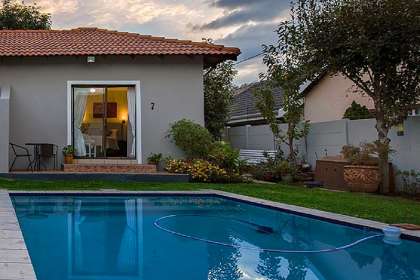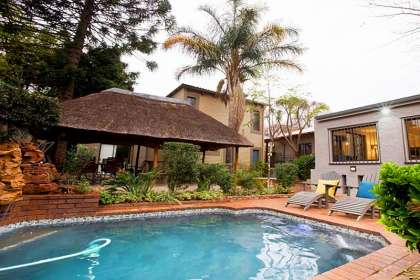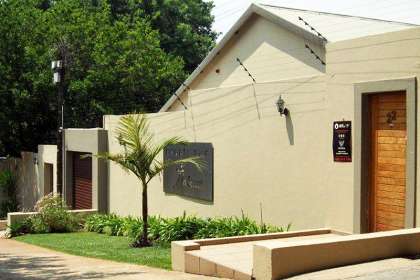Witkop Blockhouse - Vereeniging, Johannesburg
- Witkopdorp (3.23km)
- Pendale (3.86km)
- Valley Settlements (5.11km)
- Gardenvale (5.76km)
- Garthdale (5.97km)
- Henley on Klip (6.81km)
- Golf Park (9.03km)
- Greenfields (9.54km)
- Meyerton Park (10.69km)
- Meyerton (10.82km)
- Sybrand Van Niekerk Park (12.12km)
- Walkerville (12.27km)
- Brackendowns (13.34km)
- Kookrus (14.21km)
- Brackenhurst (14.95km)
- Meyerton Golf Club - Meyerton, Gauteng (9.62km)
- Diepkloof Farm Museum - Suikerbosrand Nature Reserve, Heidelberg (14.41km)
- Suikerbosrand Nature Reserve - nr Heidelberg, Southern Gauteng (17.59km)
- Klipriviersberg Nature Reserve - Johannesburg South (18.25km)
- Glenvista Country Club - Glenvista, Johannesburg (18.64km)
 The Witkop Blockhouse was declared a national monument in 1948 and is one of the last fifty left in the country. Many of the blockhouses were built by black South Africans under British supervision. (Image adapted). © Military Images
The Witkop Blockhouse was declared a national monument in 1948 and is one of the last fifty left in the country. Many of the blockhouses were built by black South Africans under British supervision. (Image adapted). © Military ImagesWitkop Blockhouse - Vereeniging, Johannesburg
The Witkop Blockhouse, located near Vereeniging in Gauteng, is a significant relic from the Second Anglo-Boer War (1899–1902). Built by British forces, it is one of many blockhouses erected across South Africa during the latter stages of the conflict to control key strategic areas, protect railway lines, and suppress the Boer guerrilla warfare tactics that defined the war's later phases.
Constructed in 1901, the Witkop Blockhouse is part of a network of over 8,000 blockhouses built by the British to maintain control over key transport routes and settlements. This particular blockhouse was strategically placed near a railway line close to Vereeniging, an important hub in the South African War. The railway was crucial for supplying British troops and moving goods, making it a prime target for Boer commandos.
The Witkop Blockhouse is a typical example of the British blockhouse design. It features a two-story, cylindrical stone structure with loopholes (small openings for rifles) in its thick walls. The upper story provided a defensive position with a clear vantage point, allowing soldiers to monitor the surrounding area and provide effective rifle fire if attacked. The lower floor served as living quarters for the garrison, typically consisting of a small group of British soldiers.
The blockhouses were instrumental in the British strategy of dividing the Boer forces and preventing their mobility across the open veld. By using blockhouses, barbed wire fences, and "scorched earth" policies, the British sought to cut off supplies and weaken the Boer resistance. The Witkop Blockhouse is a surviving example of this strategy, symbolizing the military ingenuity and harsh tactics employed during the war.
Although it never saw significant action, the blockhouse represents the broader British efforts to control the South African landscape during the conflict. Its preservation offers insight into the military architecture of the period and the realities of war for both the British soldiers stationed there and the Boer fighters who sought to evade capture.
Today, the Witkop Blockhouse is one of the few remaining well-preserved blockhouses in South Africa, as many others have fallen into disrepair or been dismantled over time. It stands as a historical monument and a testament to the tactical innovations and challenges of the Anglo-Boer War. It serves as a reminder of the conflict’s impact on the region and the lengths to which both sides went to secure victory. The Witkop Blockhouse was declared a national monument in 1948.
The blockhouse is located near Vereeniging, but it is not always staffed or formally managed as a tourist site.
Location: -26.46788353973754, 28.06954709639175
Access available at the Engen Blockhouse 1 Stop South on the R59 (car park) or the M61/Springbok Rd. (Parking on roadside).
Accommodation Near Witkop Blockhouse - Vereeniging, Johannesburg
Angelica Guesthouse
Bed & Breakfast Accommodation in Boksburg
28.6km from Witkop Blockhouse - Vereeniging, JohannesburgAngelica Guesthouse provides accommodation on a bed and breakfast and self catering basis in Boksburg on the Johannesburg East Rand. Situated in Libradene, a quiet suburb of Boksburg about 13kms from OR Tambo Airport. We're just off the N17 Freeway. …see more for bookings / enquiries and info.
Melville Gap Guest House
Self Catering Apartment, Flatlet Accommodation in Melville
29.7km from Witkop Blockhouse - Vereeniging, JohannesburgMellville Gap Guest House is situated a stone's throw from the Bohemian suburb of Melville's famous 7th Street with its vibe atmosphere, pavement cafes, cozy restaurants, antique/vintage stores and cocktail clubs, we are in the perfect location... …see more for bookings / enquiries and info.
Forest Town Guest Cottages
Self Catering House, Cottage, Chalet Accommodation in Forest Town
29.8km from Witkop Blockhouse - Vereeniging, JohannesburgForest Town Guest Cottages situated in Forest Town in Johannesburg. These attractively and comfortably furnished villas are self-contained, separate and private, 1- and 2-bedroom villas to suit families, the business traveller and tourists. …see more for bookings / enquiries and info.
7th Street Guest House
Bed & Breakfast Accommodation in Melville
30km from Witkop Blockhouse - Vereeniging, Johannesburg7th Street Guest House offers bed and breakfast accommodation in Melville, Johannesburg. With 13 luxury en suite rooms equipped with DSTV, Wifi internet access, heaters, hairdryers, fans, digital safes, coffee/tea facilities and bar fridges stocked... …see more for bookings / enquiries and info.
- Witkopdorp (3.23km)
- Pendale (3.86km)
- Valley Settlements (5.11km)
- Gardenvale (5.76km)
- Garthdale (5.97km)
- Henley on Klip (6.81km)
- Golf Park (9.03km)
- Greenfields (9.54km)
- Meyerton Park (10.69km)
- Meyerton (10.82km)
- Sybrand Van Niekerk Park (12.12km)
- Walkerville (12.27km)
- Brackendowns (13.34km)
- Kookrus (14.21km)
- Brackenhurst (14.95km)
- Meyerton Golf Club - Meyerton, Gauteng (9.62km)
- Diepkloof Farm Museum - Suikerbosrand Nature Reserve, Heidelberg (14.41km)
- Suikerbosrand Nature Reserve - nr Heidelberg, Southern Gauteng (17.59km)
- Klipriviersberg Nature Reserve - Johannesburg South (18.25km)
- Glenvista Country Club - Glenvista, Johannesburg (18.64km)





